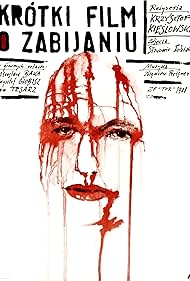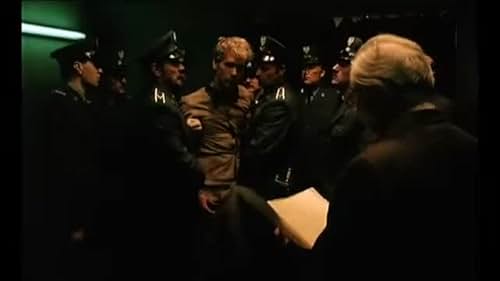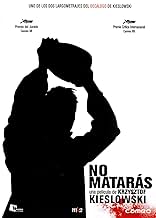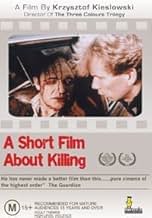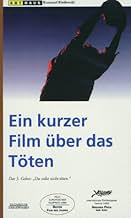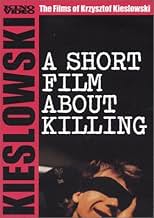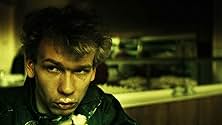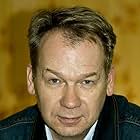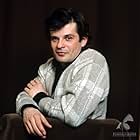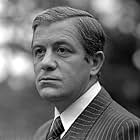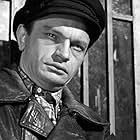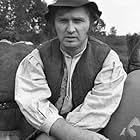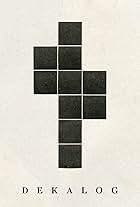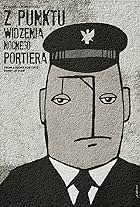VALUTAZIONE IMDb
8,0/10
22.944
LA TUA VALUTAZIONE
Un futuro avvocato incontra un tassista e un giovane uomo inquietante.Un futuro avvocato incontra un tassista e un giovane uomo inquietante.Un futuro avvocato incontra un tassista e un giovane uomo inquietante.
- Premi
- 8 vittorie e 2 candidature
Leonard Andrzejewski
- Kumpel pijanego na postoju taksówek
- (as L. Andrzejewski)
Trama
Lo sapevi?
- QuizKieslowski's graphic depiction of the effects of violence so shook up the Polish authorities that they declared a five year moratorium on capital punishment.
- Citazioni
Jacek Lazar: I didn't listen in court, not until you called to me. They were all... all against me.
Piotr Balicki: Against what you did.
Jacek Lazar: Same thing...
- ConnessioniEdited into Histoire(s) du cinéma: Une histoire seule (1989)
- Colonne sonoreOpowiem ci o lwie (I will tell you about a lion)
Lyrics by Wanda Chotomska and music by Wlodzimierz Korcz
Recensione in evidenza
Kieslowski did something essential, important; he invented something delicate in vision. It is a way of placing self so that the world appears to us as abstract but real. But rich, not simple. Textured, in such a way that the textures are in the environment, rather than objects in the environment.
This is so obvious a place to be that we forget that it was invented, not discovered. Though almost no one else achieves this balance in art, ever, it has become already something we find naturally in ourselves.
The way he achieved this was to divide his creative self, I believe. One part, he kept to himself and used in the ordinary way we do, stumbling into insightful pleasure. The other part he gave to his creative partner and lover and completely bonded the two. In practical terms, his partner created the situations and ordinary narrative shape. Dialogue.
Kieslowski was then free to shape the cinematic environment. In an ambitious project, he worked with what we call short form in ten related small films made for TeeVee. These are amazingly rich, experimental, successful. They are where he found and gave us that balance between outside and inside: observation and intimacy, narrative fold that vanishes.
But at the same time, he knew they were only sketches of what could be. He needed to take that careful balance into the long form. Now this is a major challenge, because all of a sudden the narrative becomes a spine, not a melody. It becomes the path in the environment. The environment in his carefully conceived balance now has to be dynamic. He did later achieve this in "Three Colors," one of the most important adventures in cinema.
The way he got there was by taking two of the ten decalogue films and making them long form projects. He did not do this — as is generally believed — by simply adding footage to make a short film longer. He completely reimagined the thing from scratch. It is, in fact wholly different, though all the bits of the small project are in it, they are now part of a flow. Though the thing is longer, there are many more mysteries, more story not exposed but placed in the space alone. There is a hint of multiple observation.
There is meaning now, in the car door that mysteriously closes as we see the killer dragging the body to the water.
We owe this man, this project, this killer a lot.
Ted's Evaluation -- 3 of 3: Worth watching.
This is so obvious a place to be that we forget that it was invented, not discovered. Though almost no one else achieves this balance in art, ever, it has become already something we find naturally in ourselves.
The way he achieved this was to divide his creative self, I believe. One part, he kept to himself and used in the ordinary way we do, stumbling into insightful pleasure. The other part he gave to his creative partner and lover and completely bonded the two. In practical terms, his partner created the situations and ordinary narrative shape. Dialogue.
Kieslowski was then free to shape the cinematic environment. In an ambitious project, he worked with what we call short form in ten related small films made for TeeVee. These are amazingly rich, experimental, successful. They are where he found and gave us that balance between outside and inside: observation and intimacy, narrative fold that vanishes.
But at the same time, he knew they were only sketches of what could be. He needed to take that careful balance into the long form. Now this is a major challenge, because all of a sudden the narrative becomes a spine, not a melody. It becomes the path in the environment. The environment in his carefully conceived balance now has to be dynamic. He did later achieve this in "Three Colors," one of the most important adventures in cinema.
The way he got there was by taking two of the ten decalogue films and making them long form projects. He did not do this — as is generally believed — by simply adding footage to make a short film longer. He completely reimagined the thing from scratch. It is, in fact wholly different, though all the bits of the small project are in it, they are now part of a flow. Though the thing is longer, there are many more mysteries, more story not exposed but placed in the space alone. There is a hint of multiple observation.
There is meaning now, in the car door that mysteriously closes as we see the killer dragging the body to the water.
We owe this man, this project, this killer a lot.
Ted's Evaluation -- 3 of 3: Worth watching.
I più visti
Accedi per valutare e creare un elenco di titoli salvati per ottenere consigli personalizzati
- How long is A Short Film About Killing?Powered by Alexa
Dettagli
- Data di uscita
- Paese di origine
- Sito ufficiale
- Lingue
- Celebre anche come
- Non uccidere
- Luoghi delle riprese
- Wiertnicza, Wilanów, Varsavia, Voivodato della Masovia, Polonia(taxi heading towards the river)
- Aziende produttrici
- Vedi altri crediti dell’azienda su IMDbPro
Contribuisci a questa pagina
Suggerisci una modifica o aggiungi i contenuti mancanti

Divario superiore
By what name was Breve film sull'uccidere (1988) officially released in India in Hindi?
Rispondi